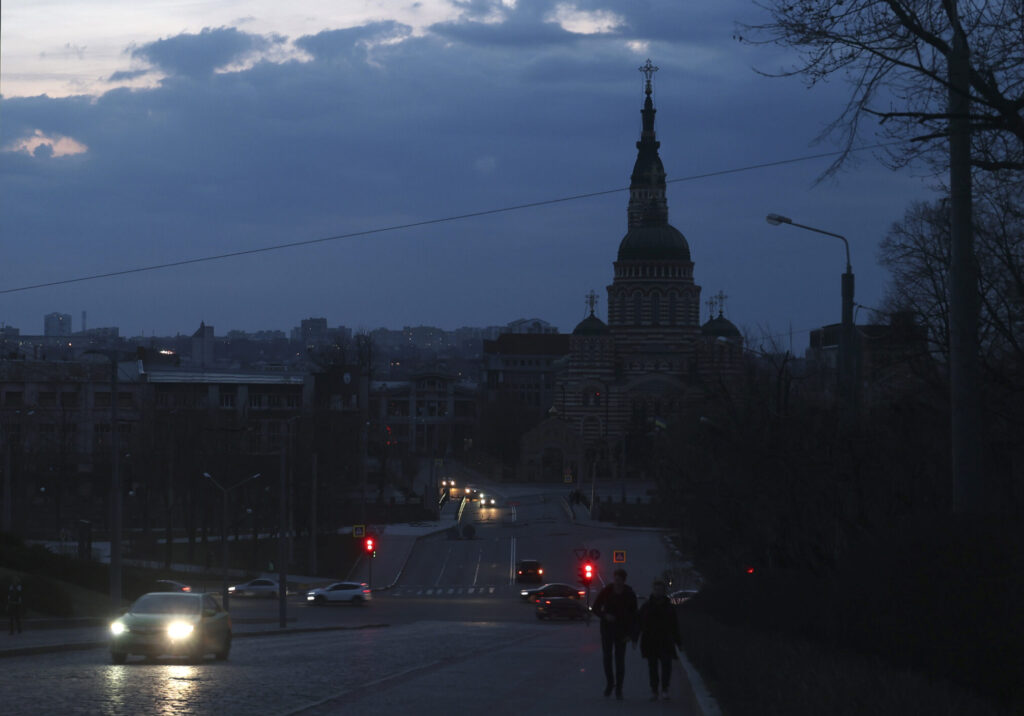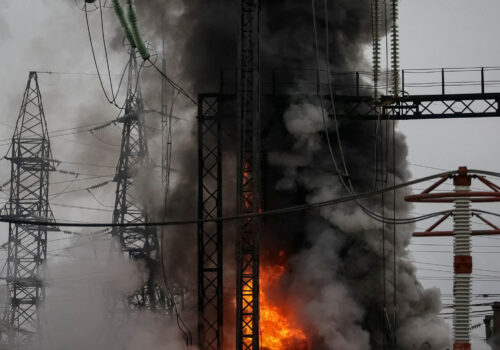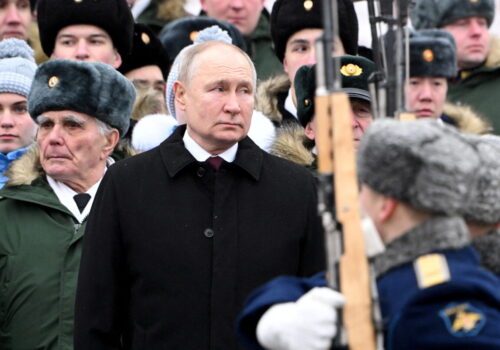Ukraine’s second city, Kharkiv, is in danger of becoming a “second Aleppo” amid a surge in Russian airstrikes, Kharkiv Mayor Ihor Terekhov warned this week. In an April 17 interview with The Guardian, Terekhov said that unless Ukraine urgently receives additional air defenses from the country’s partners, Kharkiv would suffer the same fate as Syrian city Aleppo, which was partially destroyed almost a decade ago following heavy bombing by Russian and Syrian government forces.
Terekhov is the latest in a series of high-profile voices to raise the alarm over the increasingly dire situation in and around Kharkiv. Located in eastern Ukraine close to the front and just thirty miles from the Russian border, the city has been the primary target of a new Russian air offensive that appears designed to depopulate large parts of Ukraine. “The Kremlin wants to make Ukraine’s second city unlivable,” reported The Economist in early April.
Russian attacks on Kharkiv’s civilian infrastructure and residential districts have increased dramatically over the past few months, killing dozens and leaving the city’s approximately 1.3 million residents with often sporadic access to electricity. A wave of Russian bombings on March 22 proved particularly damaging, destroying Kharkiv’s two main power plants and network of substations in a calculated move to plunge the city into darkness.
Hospitals, businesses, and homeowners are now scrambling to secure generators and other alternative power sources in anticipation of further blackouts, with children forced to study online or in makeshift underground classrooms. For now, most Kharkiv residents appear intent on staying put. However, if the situation does not improve in the coming months, there may be a mass exodus ahead of the winter season. Indeed, many fear that without enhanced air defenses, conditions inside the city could become intolerable much sooner.
Stay updated
As the world watches the Russian invasion of Ukraine unfold, UkraineAlert delivers the best Atlantic Council expert insight and analysis on Ukraine twice a week directly to your inbox.
The destruction of Kharkiv would certainly be a major war crime, but it would be far from unprecedented. On the contrary, the methodical depopulation of Ukraine’s second city would be very much in keeping with the destructive tactics employed by Russia ever since the full-scale invasion of Ukraine first began more than two years ago.
From Mariupol to Bakhmut, the Russian military has reduced a long list of Ukrainian towns and cities to rubble as it has slowly steamrollered forward along the largely static front lines of the war. Although it is not possible to accurately determine casualty figures in areas currently under Russian occupation, tens of thousands of Ukrainian civilians are believed to have been killed in Mariupol alone.
While the Kharkiv region has been the worst hit, the recent escalation in Russian bombardments has impacted the whole country, with attacks on the power grid in particular creating unprecedented challenges for the entire Ukrainian energy sector. This appears to be the result of extensive planning in Moscow, with Russian military officials learning important lessons from the failure of their winter 2022-23 energy infrastructure bombing offensive.
“Rather than continuing to focus their attacks on Ukraine’s transmission systems, Russia has began launching massive attacks on our energy generation infrastructure,” the CEO of Ukrainian energy provider DTEK, Maxim Timchenko, told CNN. “Unfortunately, the enemy has evolved his tactics and is using high-precision weapons. The result is a huge increase in its destructive effectiveness compared to 2023.”
The timing of the current bombing campaign also suggests Moscow is looking to take advantage of growing gaps in Ukraine’s air defenses. With a vital aid package held up in the US Congress for more than half a year, the Ukrainian military is currently suffering from a wide range of shortages, leaving front line commanders and air defense crews with no choice but to ration dwindling supplies of ammunition.
Eurasia Center events

Ukraine’s main port city and international maritime gateway, Odesa, has been heavily targeted in recent months. Attacks on residential areas in the Sumy and Chernihiv regions of northern Ukraine have also accelerated noticeably. In early April, a massive barrage of missiles succeeded in penetrating Ukraine’s depleted air defenses close to the country’s capital, destroying the largest power plant in the Kyiv region. “Why? Because we had zero missiles. We ran out of all missiles,” a clearly exasperated Ukrainian President Volodymyr Zelenskyy told PBS NewsHour.
Ukrainian officials are now urgently appealing for extra air defenses to help counter Russia’s bombing campaign. So far, the response has been muted, with only Germany confirming plans to hand over a Patriot system. Others, such as the Netherlands, have offered to purchase Patriot systems on behalf of Ukraine. While these steps are welcome, much more needs to be done to protect Ukraine’s civilian population and the country’s infrastructure.
Many analysts believe improved air defenses are not enough and argue that in order to effectively counter Putin’s terror-bombing tactics, Ukraine must be given the necessary long-range weapons to target Russian launch sites. However, this would require Ukraine’s partners to overcome their well-documented fear of escalation and reverse a longstanding ban on the use of Western weapons for attacks inside Russia. At present, there is little sign of that happening.
The International Criminal Court in The Hague has already issued arrest warrants for two high-ranking Russian military officers over the 2022-23 bombing of Ukraine’s civilian infrastructure, but this is of little comfort to the beleaguered Ukrainian population, who know it will be years before they see even symbolic justice served. Meanwhile, the current bombing campaign continues to gain momentum. This new air offensive is far more ambitious than Russia’s earlier efforts, with the apparent end goal of rendering entire Ukrainian regions uninhabitable.
Unless Ukraine’s air defenses are dramatically upgraded in the near future, the country will face a humanitarian catastrophe that could potentially define the future course of the war. Putin has been unable to defeat Ukraine decisively on the battlefield, but his bombing campaign may yet succeed in breaking Ukrainian resistance by forcing millions of civilians to flee their blacked out homes and ruined cities.
Peter Dickinson is editor of the Atlantic Council’s UkraineAlert service.
Further reading
The views expressed in UkraineAlert are solely those of the authors and do not necessarily reflect the views of the Atlantic Council, its staff, or its supporters.

The Eurasia Center’s mission is to enhance transatlantic cooperation in promoting stability, democratic values and prosperity in Eurasia, from Eastern Europe and Turkey in the West to the Caucasus, Russia and Central Asia in the East.
Follow us on social media
and support our work
Image: Cars move along a dark street as the city experiences power outages after a Russian missile and drone attack on Kharkiv's power system. (Photo by Vyacheslav Madiyevskyy/Ukrinform/Sipa USA)




